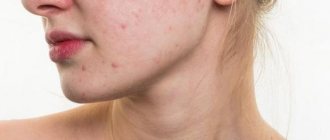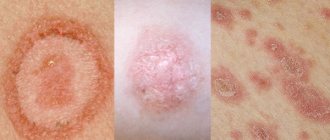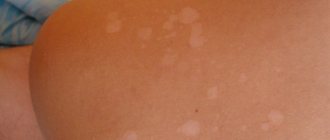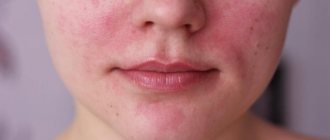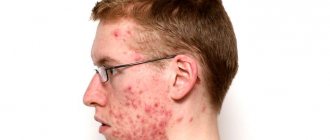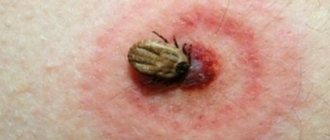Red spots on the neck may be evidence of illness, the body’s reaction to environmental factors, or the consequences of psychomotor disorders. Their appearance may be accompanied by itching and flaking. To make a correct diagnosis and find out the cause of the spots, it is recommended to consult a specialist and undergo a series of examinations.
It is prohibited to treat red spots on the neck at home, especially if they are filled with exudate and itchy. This is explained by the fact that such actions can lead to the formation of severe complications. Now we will try to figure out why red spots appear on the neck.
Causes of spots
There can be many provoking factors for the appearance of irritation on the neck. The causes of red spots on the neck are divided into:
- external,
- internal.
External factors include:
- The influence of stressful situations.
- Psycho-emotional overload.
- Insect, mosquito and bee bites.
- Staying in the open sun for a long time.
- Diaper rash.
- Allergic reactions. They can occur when eating certain foods or as a result of contact of the skin of the neck with a chain or scarf. Redness and itching on the neck may not appear immediately, which makes diagnosis difficult.
Endogenous factors are considered:
- Atopic dermatitis. The red spot on the neck itches and brings a lot of discomfort.
- Diseases of infectious origin, such as measles, scarlet fever, chickenpox.
- Eczema.
- Scleroderma. A red spot appears on the neck, which after a certain period of time swells and hardens. In some cases it can limit movement.
- Ringworm, red patches on the neck are itchy and can spread to the chest and shoulders.
- Hemangioma. This pathological condition is characterized by a red spot on the neck, which looks like a mole. It usually does not cause discomfort. If it grows, you need to seek qualified help as quickly as possible.
To determine why red spots appear on the neck of an adult or child, it is necessary to undergo a thorough diagnosis.
How to get rid
The transformation of dark spots on the neck into cancerous tumors is a serious pathology that threatens health and life. With increased melanin production, pigmentation quickly spreads throughout the body, involving new areas of the skin in the pathological process. At a certain point, epithelial cells become malignant, leading to the development of melanoma.
However, this rarely happens. The main problem that people with skin pigmentation experience is psychological discomfort. If an adult or child does not suffer from an abnormal phenomenon in the neck, there is no need to get rid of it.
It is important to consult a doctor in time, who will identify provoking factors and determine the degree of risk of the pigment spot degenerating into a malignant neoplasm.
Based on the test results and accompanying symptoms, the doctor will draw up an effective treatment regimen. You should consult a dermatologist. If necessary, the doctor will involve other specialists.
Medical cosmetics
Medical cosmetics successfully remove pigmentation. The composition of the products includes compounds with different mechanisms of action. Creams and gels contain hydroquinone, tretinoin and arbutin. These substances inhibit the synthesis of tyrosinase, an enzyme that activates the production of melanin. Popular drugs: Retinoic ointment, Achromin, Melanativ.
Products containing hydroquinone are toxic. They should not be used for a long time.
Apply the cream locally, only to the stain, without affecting healthy skin. They are treated in the autumn-winter period, when the activity of UV rays is reduced.
Products with salicylic, azelaic, ascorbic, and glycolic acid help exfoliate the pigmented epithelium. Their components, capable of destroying the dye, quickly penetrate deep into the tissue. Prescribed drugs: Belosalik, Salicylic ointment and others.
Therapeutic cosmetics effectively eliminate light spots and do an excellent job of whitening moderate focal pigmentation. The skin acquires a natural shade after 2-3 months of using cosmetics. However, it is better to use them after medical consultation.
Hardware cosmetology
Methods of hardware cosmetology are the most progressive method that allows you to permanently remove cosmetic defects on the face, neck and other parts of the body. The following procedures help to easily get rid of stains:
- Phototherapy. The affected area is treated with a beam of light waves. Thanks to them, the epithelium brightens and rejuvenates.
- Mesotherapy. The specialist uses drugs that can dissolve the pigment substance.
- Cryotherapy. Pigmentation is reduced by applying liquid nitrogen to the problem area.
- Chemical peeling. To remove dark spots, cosmetologists use preparations containing aggressive acids.
You can get rid of age spots using hardware methods only in beauty salons. Before performing the procedures, the specialist studies the course of the pathology, takes into account contraindications, and determines the nature of pigmentation.
Drug therapy
Darkening of the skin is removed with the help of medications. First, in women, men or children, the cause of the pathology is determined, then medications are selected to eliminate it. The doctor makes an appointment:
- immunostimulants,
- hormonal drugs,
- multivitamins.
Clinical picture
Symptoms of the pathological condition will depend on the provoking factor that the neck turns red and itches.
With psychomotor disorders, redness appears on the neck; it practically does not bring any pathological sensations; in rare cases, itching may occur.
If spots on the neck appeared due to diseases of a dermatological nature, then their characteristic features are that they:
- spread to the scalp and upper limbs,
- may change, fill with exudate and peel off,
- lead to itching.
In severe cases of the disease, an increase in body temperature and a deterioration in the general condition of the person may be observed.
If the cause of the spots on the neck is an allergy, then the symptoms will be almost identical to the previous case, the only difference will be the duration of their presence and severity.
In diseases of infectious origin the following will be observed:
- neck irritation
- increase in body temperature,
- headache,
- fatigue,
- a sore throat,
- cough,
- hyperhidrosis,
- production of excessive tears,
- rash over the entire body,
- clinical picture of intoxication of the body.
The following picture will be typical for autoimmune disorders:
- a red spot appears on the neck, which itches and flakes,
- deterioration of general condition,
- feeling of general weakness,
- increase in body temperature,
- blood pressure surges,
- itching
Eczema is characterized by the formation of red spots, which, as the pathological process progresses, turn into blisters. There is a feeling of unbearable itching and peeling.
Redness on the neck in women can be accompanied by disruptions in the menstrual cycle and hormonal imbalances. Representatives of the stronger half of humanity may experience a decrease in libido and impaired potency.
If red spots appear on the neck, in any situation, you must seek medical help. It is unacceptable to start treatment on your own at home.
Neurofibromatosis
There are also other, more serious causes of brown spots on the neck. These include neurofibromatosis. This disease is considered very serious. In addition to the spots, small pink nodules also appear on the neck. They are soft in structure. In addition, the bones begin to deform.
If the disease progresses to a more serious stage, then in addition to the above symptoms, the person begins to deaf and go blind. Symptoms may also appear due to the spinal cord being compressed. You should know that neurofibromatosis is a hereditary disease. A patient with this diagnosis must be constantly monitored by doctors.
Diagnostics
When visiting a medical facility, the doctor first of all conducts a general examination of the patient and collects anamnesis. If necessary, recommends obtaining advice from specialists.
In addition, he prescribes laboratory and instrumental examinations, such as:
- UAC,
- blood chemistry,
- OAM,
- immunological examinations,
- scraping from the affected area for further microscopic examination,
- Ultrasound,
- allergy tests.
After assessing the examination results, he makes a diagnosis and prescribes the optimal treatment regimen.
Fight strategy
Under no circumstances should you deal with age spots on your own, much less use bleaching agents. These include powerful drugs that can have serious side effects, and an allergic reaction is not the worst thing that can happen. After all, such drugs, if taken uncontrollably, can cause pigmentation disorders or severe dermatitis.
As a rule, simultaneously with the elimination of the cause of the appearance of age spots (and with a decrease in the production of melanin in the body), they are removed using various “grinding” methods, both chemical and mechanical. At this time, you cannot stay in the sun for a long time; you need to use fairly strong sunscreens.
Therapeutic measures
If red spots appear on the neck, treatment is carried out conservatively using traditional and folk methods. Prescribed:
- NSAIDs,
- antiallergic drugs,
- antibacterial drugs,
- antipyretics,
- sorbents.
In addition, topical medications, physiotherapeutic procedures, and diet are also used. Most often this is:
- zinc ointment,
- tetracycline ointment,
- tar soap,
- ointments made on the basis of glucocorticoids.
If red spots appear on the neck and itch, you need to observe them for some time. If these are allergy symptoms, they may go away on their own. To eliminate itching, you can apply ointments with a cooling effect to the affected areas.
When diagnosing hemangioma, treatment is usually performed surgically using a laser, because conservative treatment will not give the necessary positive result.
If the irritation on the neck itches and peels, this indicates a dermatological disease. In the vast majority of cases, lichen is diagnosed.
With timely seeking medical help and proper treatment, relief comes quickly enough.
Drug and device therapy
The pharmaceutical industry has long studied and implemented methods for lightening the skin, so there are many means to solve the dermatological problem.
What changes melanin synthesis:
- reduction of pigment (cosmetics with hydroquinone, Neoton, Expigment);
- increase (vitamin A solution, Pro Soleil, Nature Tan, Bevital-San).
When brown spots on the neck itch, patients often misdiagnose it. Itching is a symptom of a mycotic process that leads to the growth of red-brown rashes characteristic of lichen. Such changes are eliminated by applying antifungal agents: Clotrimazole, Lamisil, Miconazole.
Medicinal substances are also administered subcutaneously - this procedure is called mesotherapy. An alternative method is the use of ultrasound, in which a solution is smeared on the dermis, and then vibration waves are released.
Procedural treatment of dermis:
- phototherapy (exposure to flashes of light of a certain wavelength);
- deep peeling (cleaning the top layer with a mechanical brush);
- laser therapy (exfoliation of skin areas that have darkened above normal with a light beam);
- cryotherapy (dispersion of liquid nitrogen to normalize cellular metabolism).
The need to visit a cosmetologist complicates the treatment of hyperpigmentation in men, since they rarely agree to go to beauty salons. Many representatives of the stronger sex are also less scrupulous about their appearance, so they are in no hurry to remove stains, which girls often perceive as disfiguring defects.
Conclusion
It’s unpleasant when pigment spots appear on the neck, but with modern developments in medicine (at a rather impressive pace), they are easy to get rid of. However, cosmetic services only eliminate the consequences, so it is also important to identify the root cause, which is often damage to an organ.
In addition to pathological processes on the neck, brown spots can appear due to a person’s age. In this case, the patient will be prescribed vitamins and other elements that are lacking in the body. These medications should be taken orally. You should also actively use external ointments and creams.
Recipes from folk sources
Treatment will be more effective if you combine traditional methods of treatment with folk ones, but this must be agreed with your doctor. Traditional medicine recommends:
- treat a red spot on the neck that itches with calendula infusion,
- lubricate the affected areas with iodine solution,
- apply lotions made from apple cider vinegar and mustard powder,
- apply a cabbage leaf greased with sour cream to the rash elements,
- drink nettle decoction,
- wipe areas of skin with a rash with lemon juice, but only if they are not irritated,
- apply grated carrots, it improves the condition of the skin,
- make a mask from chopped parsley,
- Lubricate affected areas with sour cream.
A positive effect is observed from the use of:
- Lotions prepared on the basis of infusion of birch buds. It is recommended to pour 1 tbsp. l. kidneys 250 ml. boiling water and leave for several hours. Strain and apply to the affected area for a quarter of an hour.
- Oatmeal scrub. To prepare, you need to mix oatmeal, milk and blue clay in equal quantities. Apply the resulting mixture to the stains and leave for 15 minutes, then rinse with water.
- Infusion of nettle, celandine and yarrow.
Symptoms
A dark spot on the neck may be a sign of type 2 diabetes. They may also appear in the groin and armpits. This phenomenon is associated with changes in insulin metabolism. As a result, the folds of the skin become darker and rougher.
The best way to get rid of these brown spots on the neck is to treat the disease that is associated with them, i.e. diabetes. The use of certain types of medications can also contribute to the appearance of these spots. These are growth hormones and hormonal contraceptives.
Using dermatological products—ointments, lotions, and creams—softens stains but may not remove them completely. Additionally, since this darkening of the skin is a sign of disease, it is important to treat the cause not only for aesthetic purposes but also for health. Responsibility for the prescribed diabetes therapy lies with the endocrinologist.
Red spots on the skin are a symptom that can be caused by many factors. They can be localized (that is, limited to certain areas of the body, such as the face or torso) or widespread (where the rash occurs over large areas). Redness can develop on the surface of the skin, but can also be associated with reactions that occur deep in the subcutaneous tissue.
When scarlet patches appear on the skin, the number, size and distribution of skin lesions, progression over time, and the appearance of additional symptoms are important aspects of the differential diagnosis. Therefore, when you have to deal with such a phenomenon, it is important to contact an experienced dermatologist, who, based on the provoking factor, will recommend the most suitable treatment.
As a rule, the patient does not present any complaints other than the appearance of an area with impaired pigmentation. Despite the fact that there is no pain, burning or itching (symptoms that are observed in other dermatological pathologies), you should consult a doctor for a full diagnosis and treatment. It must be remembered that only a specialist can accurately determine the type of pigment spot. It is necessary to urgently consult a doctor if the pigment spot has become asymmetrical, has changed color and size, and its contours have become uneven.
Measures aimed at preventing the appearance of red spots
In order to reduce the risk of the formation of red spots and irritations on the skin, it is recommended:
- use only high-quality cosmetics;
- avoid prolonged exposure to the open sun, and if this is not possible, use protective equipment;
- adhere to a balanced diet;
- maintain personal hygiene;
- to refuse from bad habits;
- exercise;
- treat chronic diseases in a timely manner.
Particular attention should also be paid to undergoing preventive examinations, because this will prevent the development of the disease and the appearance of red spots.
To summarize, I would like to emphasize that skin irritation and spots should make you see a doctor. This will allow you to find out the true cause of this rather unpleasant symptom (especially in aesthetic terms) and eliminate it easily and quickly. Be attentive to your body, and it will thank you with good health.
Many people have encountered a situation where redness of the chest and neck occurred. In some situations, such a symptom is not serious, for example, it is observed with anxiety due to a rush of blood, but there are cases when it indicates the presence of serious health problems.
That is why it is important to understand why such deviations from the norm appear.
Causes in an adult
Rashes around the neck can appear under the influence of external factors or internal changes. Throughout life, people encounter many irritants that can affect the condition of the skin and the body as a whole. Among the trivial factors, it is worth noting the following:
- Friction from clothing (tight collars, scarves, ties).
- Damage caused by shaving in men.
- Intolerance to cosmetics.
- Neglect of personal hygiene rules.
- Skin contamination with chemicals.
- Insect bites (mosquitoes, ticks, bedbugs).
People with a labile nervous system may develop cholinergic urticaria, which is not associated with exposure to allergens. Irritants may include overheating, sweating, stressful situations, and taking certain medications. A similar reaction occurs upon contact with ultraviolet rays, cold air, and water.
Red on the face and back due to acne
Beginning in adolescence, many young people suffer from acne, which is usually associated with hormonal changes that increase sebum production. In conditions of hyperkeratosis of the excretory ducts of the glands, they become blocked, and bacteria multiply inside, causing inflammation.
Acne does not only appear on the face; in some people, it affects other areas of the body. Deep pimples can occur on the neck, back, and upper chest, which is observed with conglobate (spherical) acne. The distinctive features of this form are as follows:
- Large infiltrates tend to merge to form a bumpy surface.
- Abscess formation occurs in the center of some elements.
- After healing, scar changes remain.
Usually, papulopustular elements appear that do not penetrate the dermis, and therefore after healing can leave only temporary redness or pigmentation. The mildest course of acne is accompanied by open or closed comedones - the latter look like small white pimples.
An acne rash usually affects areas with an increased number of sebaceous glands, but it also occurs in other places.
Itching due to hives and dermatitis
Itchy rashes on the neck often indicate the development of an allergic reaction. Substances of various origins can sensitize the body:
- Plant (pollen, fluff, odors).
- Animals (wool, feathers, ticks).
- Insect (bee venom).
- Food (seafood, fish, eggs, citrus fruits, strawberries, nuts, chocolate).
- Medicinal (antibiotics, sulfonamides, local anesthetics, salicylates).
- Household (detergents, cosmetics, nickel-plated jewelry, latex).
Hypersensitivity reactions underlie many dermatological diseases. When the skin comes into contact with irritants, allergic dermatitis occurs. Against the background of redness and swelling, small papules and blisters appear, accompanied by itching. A similar picture, but with more pronounced weeping, spreading to other areas and persisting after elimination of the causative factor, is observed with eczema.
A sign of food allergy is often urticaria, which is manifested by the appearance of urticarial elements. They are represented by edematous blisters slightly raised above the surface of the skin. They have a pink-red color and polygonal outlines, and are prone to merging. The rash may be accompanied by low-grade fever, weakness, headaches, and dyspeptic disorders.
Another cause of an itchy rash on the neck is atopic dermatitis, which most often affects women. The disease begins in childhood, when it takes on the character of eczema. Subsequently, the lesions become covered with dense papules, become infiltrated, with peeling and increased skin pattern (lichenization). Intense itching leads to neurotic disorders, creating a lot of troubles in everyday life.
Blistering rashes due to herpes
Signs of herpes zoster are often found in the neck area. It is caused by a virus that, upon initial infection, gives the clinical picture of chickenpox, and local changes on the skin are considered a late relapse of the infection. The process is activated when the body’s reactivity decreases:
- Hypothermia.
- Immunodeficiencies.
- Oncological processes.
- Taking certain medications (corticosteroids, cytostatics, antibiotics).
- Radiation therapy.
- Pregnancy.
Skin rashes are localized along the nerve trunks and are unilateral. They are preceded by signs of intoxication (fever, malaise, headaches), tingling, burning, itching and pain in the neck. Against this background, edematous spots first appear, which after a couple of days turn into papules and blisters. After a week, the latter dry out and become crusty.
Blistering elements on the skin are a characteristic sign of a herpes infection. Local damage to the neck occurs with herpes zoster.
Pustules due to pyoderma
The submental area and neck, especially the back surface, can be affected by pustular processes. In men, sycosis may appear when folliculitis in the beard area merges with each other, forming a continuous bluish-red infiltration with a conglomerate of pustules. After opening the latter, the pus shrinks into dirty yellow crusts that glue the hairs together. The disease often recurs, bringing emotional discomfort.
In the area of the back of the neck, boils often form, which are purulent-necrotic inflammation of the hair follicles. First, a red spot appears on the skin, transforming into a painful nodule with swelling and hyperemia. As the necrotic core matures, it acquires a cone-shaped shape with a pustule in the center. At this time, local pain and malaise are disturbing, and the temperature rises. After the pus drains, the symptoms subside.
Systemic disorders
Rashes on the neck can be systemic in nature, arising due to immunopathological or infectious disorders that create the preconditions for changes in the skin. Among these diseases it is worth noting the following:
- Psoriasis.
- Lupus erythematosus.
- Syphilis.
Psoriatic plaques occur anywhere on the body. At first they appear as small, round, pink-red papules with a rough, scaly surface. Then they increase in size and merge with each other, acquiring irregular shapes. When plaques are scraped, the following symptoms occur:
- Stearine stain – silvery-white scales.
- Terminal film has a bright red surface.
- Blood dew - drip bleeding.
